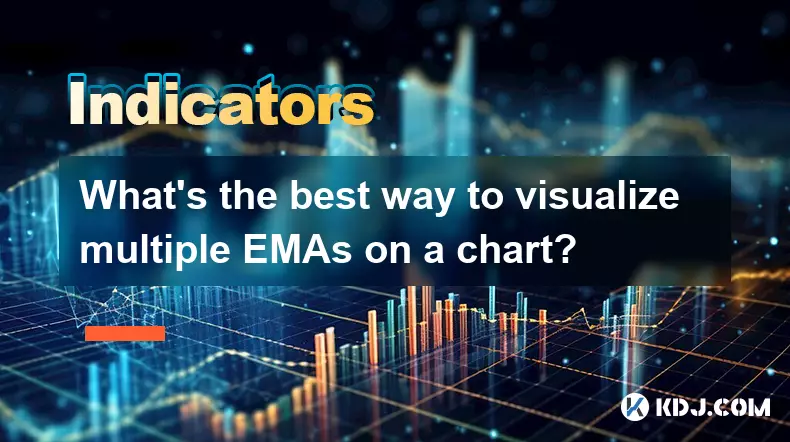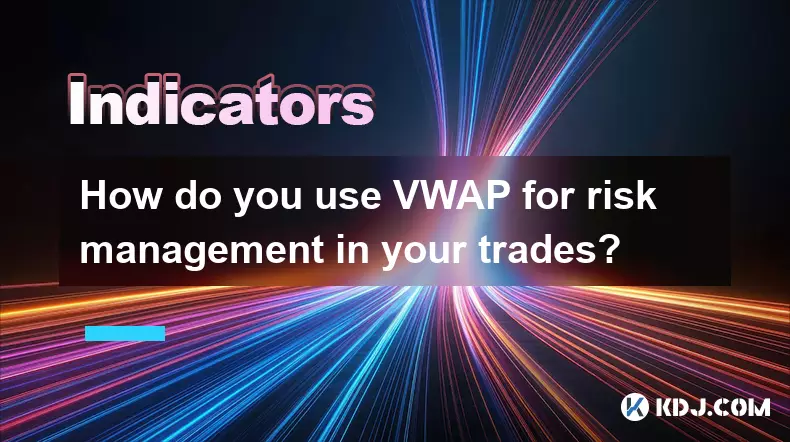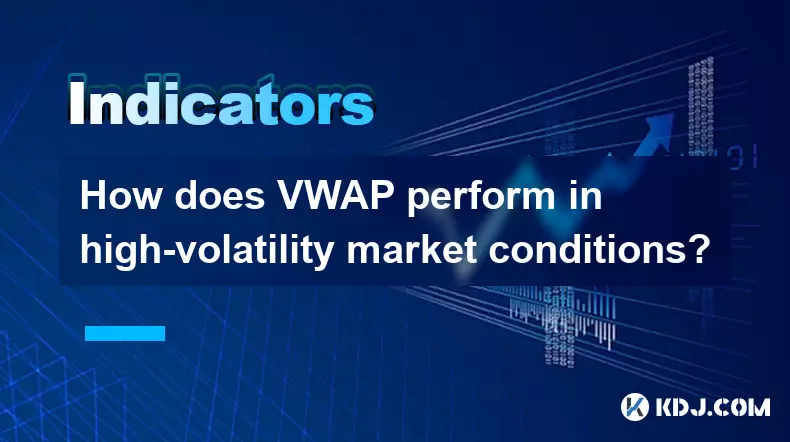-
 bitcoin
bitcoin $110047.851143 USD
-1.37% -
 ethereum
ethereum $3727.617466 USD
-1.30% -
 tether
tether $1.000961 USD
-0.05% -
 bnb
bnb $1114.045467 USD
1.72% -
 xrp
xrp $2.343280 USD
0.14% -
 solana
solana $174.674876 USD
-5.85% -
 usd-coin
usd-coin $0.999999 USD
0.02% -
 tron
tron $0.311757 USD
-2.44% -
 dogecoin
dogecoin $0.183678 USD
-3.76% -
 cardano
cardano $0.627109 USD
-2.07% -
 ethena-usde
ethena-usde $1.000300 USD
0.15% -
 hyperliquid
hyperliquid $36.865760 USD
-2.74% -
 chainlink
chainlink $16.968918 USD
-1.48% -
 stellar
stellar $0.318159 USD
0.47% -
 bitcoin-cash
bitcoin-cash $500.637224 USD
-1.56%
What's the best way to visualize multiple EMAs on a chart?
Using multiple EMAs—like 9, 21, and 50—with distinct colors and thickness improves trend analysis and crossover detection in crypto trading. (154 characters)
Oct 11, 2025 at 07:36 pm

Understanding the Role of Multiple EMAs in Technical Analysis
1. Exponential Moving Averages (EMAs) are widely used in cryptocurrency trading due to their responsiveness to recent price changes. Traders often overlay several EMAs with different periods—such as 9, 21, and 50—to gain layered insights into market momentum and trend direction. The shorter the EMA period, the more sensitive it is to price fluctuations, making it ideal for detecting early shifts.
2. When visualizing multiple EMAs on a single chart, clarity becomes crucial. Overlapping lines with similar colors or thickness can create confusion, especially during volatile market conditions. Assigning distinct colors to each EMA helps differentiate them quickly. For example, using green for the 9-period EMA, blue for the 21, and red for the 50 allows traders to identify crossovers and divergences at a glance.
3. Adjusting line thickness based on significance improves readability. The most frequently referenced EMA, such as the 21-period, might be slightly thicker than others. This subtle emphasis guides attention without cluttering the chart. Transparency settings can also be applied so that price candles remain visible beneath dense clusters of moving averages.
4. Positioning EMAs across various timeframes enhances strategic depth. A trader analyzing a 4-hour chart may include EMAs tailored for short-term scalping alongside longer-term trend filters. This multi-layered approach supports both entry timing and broader directional bias assessment.
5. Some advanced charting platforms allow dynamic coloring of EMAs based on slope or relationship to price. An EMA turning upward could automatically shift to green, while a downward slope turns red. This feature reduces cognitive load by encoding trend strength directly into the visual layer.
Optimizing Chart Layout for EMA Clarity
1. Selecting the right chart type is essential. Candlestick charts remain the standard in crypto trading, offering rich visual data that pairs well with overlaid EMAs. Heikin-Ashi charts can also complement EMA analysis by smoothing out noise and highlighting sustained trends more clearly.
2. Vertical spacing between EMAs should reflect their mathematical separation. On highly compressed charts, closely spaced EMAs may appear merged, leading to misinterpretation. Zooming in or adjusting the scale temporarily can reveal hidden relationships, such as a short-term EMA coiling around a longer one before a breakout.
3. Using secondary panels for derived EMA metrics—like EMA ribbons or rate-of-change indicators—keeps the main price chart uncluttered. For instance, plotting the difference between the 9 and 50 EMAs in a separate window highlights convergence and divergence phases without interfering with price action.
4. Grid alignment and background themes impact perception. Dark mode with muted grid lines reduces eye strain during extended monitoring sessions, while light mode may enhance contrast for printed reports. Consistent axis scaling ensures that EMA angles accurately represent momentum shifts.
5. Interactive tooltips that display exact EMA values on hover add precision. During fast-moving events like exchange outages or macroeconomic announcements, knowing the precise distance between price and key EMAs aids rapid decision-making.
Leveraging EMA Crossovers and Channel Formations
1. Visualizing EMA crossovers effectively requires temporal context. Animating historical crossovers through backtesting tools reveals how frequently false signals occur versus reliable entries. Plotting arrows or markers at crossover points adds navigational cues without altering baseline aesthetics.
2. Grouping EMAs into ribbons creates dynamic support and resistance zones. A cluster of five EMAs fanning upward suggests strong bullish momentum, while a collapsing ribbon indicates weakening trend energy. Color gradients within the ribbon—transitioning from cool to warm tones—can illustrate acceleration.
3. Dynamic bands formed by the highest and lowest EMAs in a set act as adaptive channels. Price bouncing off the upper EMA band may signal overbought conditions, while rejections from the lower band hint at capitulation. These boundaries adjust automatically with volatility, unlike fixed percentage envelopes.
4. Time-based filtering prevents overcrowding. Displaying only intraday EMAs during active trading hours and switching to daily aggregates after market close maintains relevance. Automated scripts can toggle visibility based on session type or asset liquidity cycles.
5. Integrating volume-weighted EMAs introduces another dimension, aligning trend signals with participation levels. When a rising EMA coincides with above-average volume, the conviction behind the move increases significantly.
Frequently Asked Questions
How many EMAs should I display on a single chart?Displaying three to five EMAs is typically sufficient. Too many lines create visual noise, making it difficult to interpret signals. Focus on periods that align with your trading strategy—common combinations include 9, 21, 50 for swing trading or 12, 26, 200 for position trading.
Can EMAs be used effectively in ranging markets?Yes, but interpretation differs. In sideways markets, EMAs tend to flatten and converge. Traders watch for price oscillations around the central EMA, treating it as a mean-reversion anchor. Breakouts are confirmed when price sustains movement beyond the outer EMAs with increased momentum.
What charting platforms offer the best EMA customization?TradingView leads in flexibility, supporting custom scripts, color logic, and dynamic styling for EMAs. ThinkorSwim and MetaTrader also provide robust options, though with steeper learning curves. For crypto-native solutions, platforms like Bybit and Binance offer built-in EMA tools with real-time syncing across devices.
Disclaimer:info@kdj.com
The information provided is not trading advice. kdj.com does not assume any responsibility for any investments made based on the information provided in this article. Cryptocurrencies are highly volatile and it is highly recommended that you invest with caution after thorough research!
If you believe that the content used on this website infringes your copyright, please contact us immediately (info@kdj.com) and we will delete it promptly.
- XRP Price Prediction: Weekend Rollercoaster or Rally?
- 2025-10-12 08:45:16
- Bittensor (TAO): Super Bullish Signals Point to Potential 2x Rally
- 2025-10-11 10:25:12
- Silver Price Correction: Navigating the Dip & Identifying Key SEO Keywords
- 2025-10-11 10:25:12
- Decoding Crypto Trends: Bittensor's Bull Run, Cardano's Dip, and LivLive's Presale Buzz in 'Uptober 2025'
- 2025-10-12 08:45:16
- MoonBull: The Crypto Meme Coin Promising 1000x Gains?
- 2025-10-11 10:30:01
- Crypto Payroll Revolution: Stablecoins, Altcoins, and the Future of Salary Payments
- 2025-10-11 10:30:01
Related knowledge

What's the main difference between VWAP and TWAP?
Oct 12,2025 at 11:54am
Understanding VWAP and Its Role in Crypto Trading1. Volume Weighted Average Price (VWAP) is a trading benchmark that calculates the average price of a...

How do you identify exhaustion moves using VWAP and its bands?
Oct 12,2025 at 08:00am
Understanding the Role of Decentralized Exchanges in Crypto Trading1. Decentralized exchanges (DEXs) operate without a central authority, allowing use...

What are the main advantages of using VWAP over EMA?
Oct 11,2025 at 02:18am
Main Advantages of Using VWAP Over EMA1. Volume-Weighted Average Price (VWAP) incorporates trading volume into its calculation, offering a more accura...

How do you use VWAP on different chart types like Heikin Ashi?
Oct 11,2025 at 05:01pm
Understanding VWAP in the Context of Heikin Ashi Charts1. The Volume Weighted Average Price (VWAP) is a powerful analytical tool commonly used by trad...

How do you use VWAP for risk management in your trades?
Oct 11,2025 at 02:54am
Understanding VWAP as a Dynamic Benchmark1. The Volume Weighted Average Price (VWAP) serves as a crucial reference point in intraday trading by reflec...

How does VWAP perform in high-volatility market conditions?
Oct 10,2025 at 08:00pm
Understanding VWAP in Turbulent Market Phases1. Volume-Weighted Average Price (VWAP) serves as a benchmark for institutional traders aiming to assess ...

What's the main difference between VWAP and TWAP?
Oct 12,2025 at 11:54am
Understanding VWAP and Its Role in Crypto Trading1. Volume Weighted Average Price (VWAP) is a trading benchmark that calculates the average price of a...

How do you identify exhaustion moves using VWAP and its bands?
Oct 12,2025 at 08:00am
Understanding the Role of Decentralized Exchanges in Crypto Trading1. Decentralized exchanges (DEXs) operate without a central authority, allowing use...

What are the main advantages of using VWAP over EMA?
Oct 11,2025 at 02:18am
Main Advantages of Using VWAP Over EMA1. Volume-Weighted Average Price (VWAP) incorporates trading volume into its calculation, offering a more accura...

How do you use VWAP on different chart types like Heikin Ashi?
Oct 11,2025 at 05:01pm
Understanding VWAP in the Context of Heikin Ashi Charts1. The Volume Weighted Average Price (VWAP) is a powerful analytical tool commonly used by trad...

How do you use VWAP for risk management in your trades?
Oct 11,2025 at 02:54am
Understanding VWAP as a Dynamic Benchmark1. The Volume Weighted Average Price (VWAP) serves as a crucial reference point in intraday trading by reflec...

How does VWAP perform in high-volatility market conditions?
Oct 10,2025 at 08:00pm
Understanding VWAP in Turbulent Market Phases1. Volume-Weighted Average Price (VWAP) serves as a benchmark for institutional traders aiming to assess ...
See all articles









































































